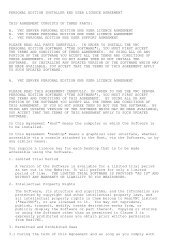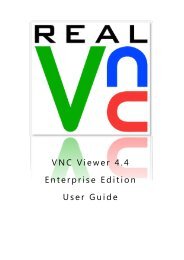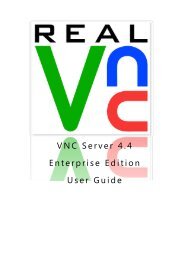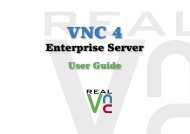VNC User Guide - RealVNC
VNC User Guide - RealVNC
VNC User Guide - RealVNC
You also want an ePaper? Increase the reach of your titles
YUMPU automatically turns print PDFs into web optimized ePapers that Google loves.
Chapter 6: Setting Up <strong>VNC</strong> Server<br />
<strong>VNC</strong> Server can run as many times as your license permits. Each time a host computer user starts <strong>VNC</strong><br />
Server (in either mode), the count of remaining desktops (that is, instances of <strong>VNC</strong> Server) is decremented.<br />
To see how many desktops are left, run the command vnclicense -check. For example, the output:<br />
Licensed desktops: 5<br />
Running desktops: 3<br />
johndoe: 2<br />
janedoe: 1<br />
means that five <strong>VNC</strong> Server desktops are licensed to run concurrently on this host computer, and three are<br />
already running; two started by John Doe, and one by Jane Doe. Two are left to run.<br />
Note: You can release licenses by killing desktops. To see how to do this, read Stopping <strong>VNC</strong> Server on<br />
page 95.<br />
Mac OS X<br />
Under Mac OS X, a user with administrative privileges can start <strong>VNC</strong> Server in Service Mode. This means<br />
<strong>VNC</strong> Server runs, and users can connect, irrespective of whether or not a host computer user is logged on.<br />
By default, in order to connect to:<br />
• <strong>VNC</strong> Server (Enterprise) or <strong>VNC</strong> Server (Personal), users must know the user name and password of a<br />
member of the admin group.<br />
• <strong>VNC</strong> Server (Free), users must know the <strong>VNC</strong> password.<br />
Once connected, users have the same privileges (that is, access rights) as the currently logged on host<br />
computer user. For more information on privileges, see Authenticating connections to <strong>VNC</strong> Server on<br />
page 98.<br />
Depending on the terms of your license, a host computer user can also, or alternatively, log on and start<br />
<strong>VNC</strong> Server in <strong>User</strong> Mode. This means <strong>VNC</strong> Server runs, and users can connect, just while this host<br />
computer user is logged on (connections are terminated at log off). By default, in order to connect to:<br />
• <strong>VNC</strong> Server (Enterprise) or <strong>VNC</strong> Server (Personal), users must know the user name and password of the<br />
host computer user starting <strong>VNC</strong> Server.<br />
• <strong>VNC</strong> Server (Free), users must know the <strong>VNC</strong> password.<br />
Once connected, users have the same privileges (that is, access rights) as this host computer user. For<br />
more information on privileges, see Authenticating connections to <strong>VNC</strong> Server on page 98.<br />
Under Mac OS X, providing Fast <strong>User</strong> Switching is turned on, more than one host computer user can log on<br />
at a time. Each currently logged on host computer user can start <strong>VNC</strong> Server in <strong>User</strong> Mode, and all<br />
instances, for all users, run concurrently. Note that all instances, in either mode, must listen on different<br />
ports; see Configuring ports on page 88 for more information.<br />
<strong>VNC</strong> Server can run as many times as your license permits. Each time <strong>VNC</strong> Server is started, the count of<br />
remaining desktops (that is, instances of <strong>VNC</strong> Server) is decremented. To see how many desktops are left,<br />
run the command /Library/<strong>VNC</strong>/vnclicense -check in a Terminal window. For more information on<br />
the message that is displayed, see the UNIX and Linux section above.<br />
80 <strong>VNC</strong> <strong>User</strong> <strong>Guide</strong>
















